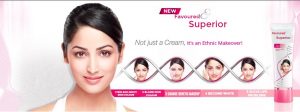The Original Ad

Fair and Lovely is a skin lightening product and brand that has been dominating the South Asian beauty market for years. This product is especially popular in India and is known for its controversial ads. Being East Indian, I have seen this product being used by my family members and never questioned the negative effects of the product until entering university. This advertisement says a lot about how Globalization affects the East. In the Unit 3 lecture notes from class, Globalization is defined as “…Western (or American to be more precise) domination of the globe, where local economic, political, and cultural lives and structures are increasingly Westernized/Americanized”. There are many aspects of this advertisement that demonstrates how much influence the West has on Indian beauty trends and values.
In this unit we discussed how some feminists believe that the world is becoming more equal, but this is not what this advertisement implies. I argue that this Fair and Lovely ad is a direct example of how there is still an uneven power relation between the West and the East. The product is marketed as a skin lightening product that establishes racial insecurity and Western dominance and femininity. The ad that I chose presents a DNA structure that displays the stages of the product, which can be implying that this product can not only make you white externally, but internally as well. Fair and Lovely uses the idea of whiteness as a progressive ideal not only for your skin but for your life. I believe this is tied to the West always being portrayed as modern and advanced. This ad is problematic for many reasons, but mainly because it implies that Western femininity and ideals will bring you happiness and success, unlike embracing your natural skin colour and ethnic identity.
Jammed Version of Ad

I chose to change three important aspects of the product to showcase how a skin lightening product can imply more than just lighter skin. I first changed the product’s name to “Favoured & Superior” to showcase how products like Fair and Lovely help favour whiteness and Western femininity in countries like India. There is nothing “Fair and Lovely” about making women believe that being white will make them more beautiful. I also chose to change the steps of the product to, “Step 1. Feel Bad About Skin Colour, Step 2. Blame Skin Colour, Step 3. Change Genetic Makeup, Step 4. Become White and Step 5. Solve Life Problems,” to showcase how the ad portrays the DNA structure to imply that the product can also make you white internally and, therfore successful. Many Fair and Lovely ads consist of a woman who is facing a moral or life dilemma, like a financial crisis or getting married, and somehow by using the product these problems are solved, which then makes life suddenly brighter and better. These ads are implying that being fair skinned will make you more successful, which can create racial insecurities for many coloured women. This also ingrains the idea that one must be fair skinned to be feminine and attractive. If being more white can get you a job or get you a husband then why would anyone want to be dark skinned?
I also chose to change the phrase in the ad to “Not just a Cream, It’s an Ethnic Makeover!” to highlight how this ad can be interpreted as directly implying that this product will make you a white person. The DNA structure and nature of the ad re-establish the notion of white being better. This in turn solidifies the West being dominant over the East. If products like Fair and Lovely are highly popular in the East then it becomes extremely difficult for coloured women to be secure in their skin. This can further lead women to believe that the best way to achieve beauty and success is to become more Westernized, and in this case, become more white.
Reference List
“ADVANCED MULTI VITAMIN SPF 15 CREAM.” Fair and Lovely, www.fairandlovely.in/products/advance-multi-vitamin-spf-15-cream.
“”Fair & Lovely” Isn’t Fair Or Lovely At All.” Honi Soit, 19 Aug. 2015, honisoit.com/2015/08/fair-lovely-isnt-fair-or-lovely-at-all/.